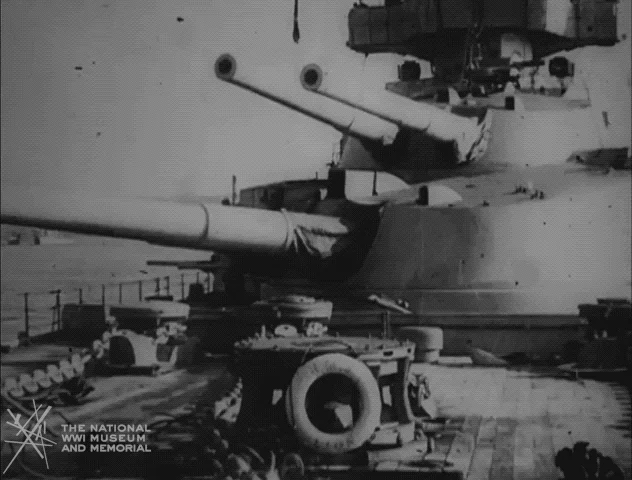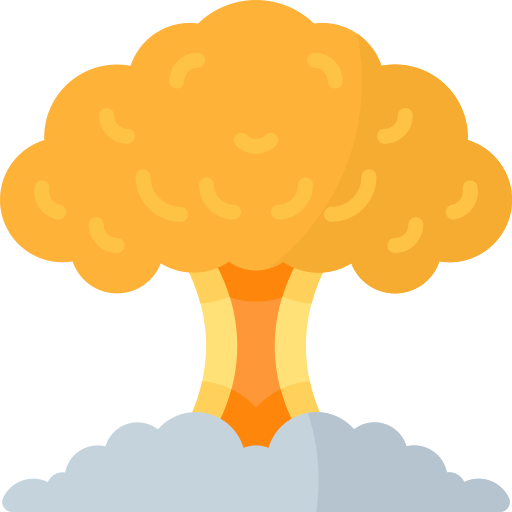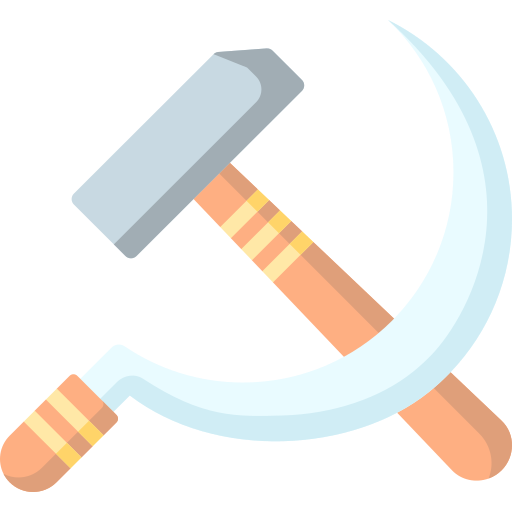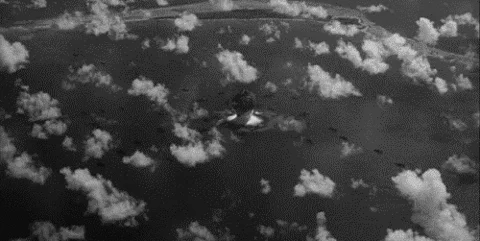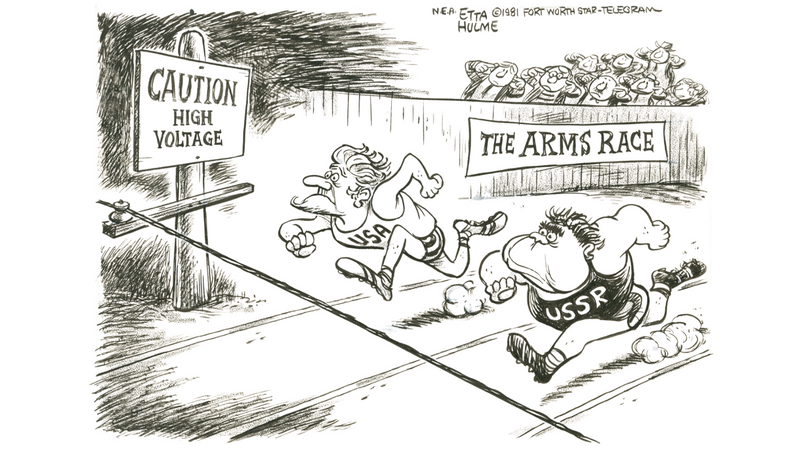
The Cold War nuclear arms race was both a jog and a sprint. The United States and the Soviet Union jockeyed to gain an advantage over one another as quickly as research and development would allow.
But as long as tensions between the United States and the Soviet Union persisted, there appeared to be no end in sight.
Paul Warnke, a notable American Cold War arms controller, described the superpowers as "apes on a treadmill."

Warnke was referring to what political scientists call the action-reaction model of arms racing:
➡️ Country A builds weapons and capabilities which inspire fear and dread in Country B.
⬅️ Country B builds weapons to match and counter Country A's.
➡️ But no one is safer because Country B responds to Country A's weapons with more advanced weapons.
⬅️ And on...
➡️ ...and on it goes.
The Cold War nuclear arms race wasn't history's first arms race.
Arms races can happen anytime new military technology arrives on the scene. For example, before World War I, the advent of the Dreadnought — a large, mighty battleship — sparked an arms race between Germany and Great Britain.
Arms races can be dangerous. If one country thinks it's winning, it may be tempted to start a war while its adversary is weak or if it suspects its adversary could surpass them in strength in the near future.
Arms races also suck up a lot of resources, which could be spent elsewhere.

Nuclear weapons upped the ante.
Battleships could do much damage, but only a tiny fraction of the Cold War's nuclear weapons could unleash catastrophic destruction on a global scale.
And because nuclear weapons are so destructive, many people who think about them have determined that they don't have much use besides deterring other countries from using their nuclear weapons or attacking other nuclear-armed countries.
So, if nuclear weapons are so powerful that they can't be used, what explains the Cold War arms race?
We'll help you answer this question and more in this Byte.
On your mark, get set, go! We're off to the races.

Early Cold War
The United States became the first to enter the Atomic Age in 1945. And for the next four years, it was the world's sole nuclear power.
But it struggled to find a use for atomic weapons.
American Atomic Monopoly
As the Cold War set in, America's atomic bombs supported Washington's plans to defend Europe. The Soviet Union's conventional (in other words, nonnuclear) armed forces outnumbered those of Western Europe and what America could reasonably deploy to the continent.

But because the United States had these destructive weapons, Washington felt more secure than it otherwise would. America, however, ran into a few problems:
Fissile material — the stuff needed to make atomic bombs — was in short supply.
Soviet air defenses were thick, so very few American bombers would likely have reached their targets.
Overseas bases, where many bombers would take off from, could be destroyed.
The atomic bomb was untested on military targets, which posed a challenge: troop columns could disperse, rendering these weapons ineffective.
The bomb didn't give American diplomats the leverage in negotiations they had initially hoped for.
Many strategic thinkers influential in policy deliberations had quickly concluded that the power of the A-bomb was too great to be used like any other weapon: it was to be a weapon of last resort.
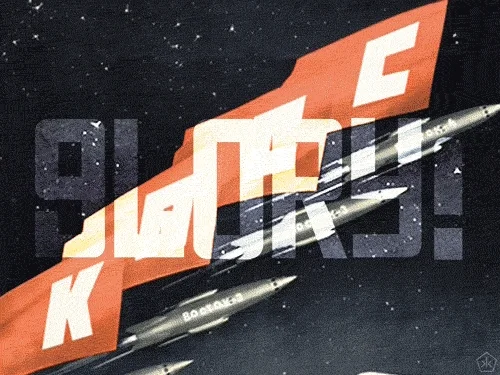
The Soviets Enter the Atomic Age
The Soviet Union's views — especially those of its leader, Joseph Stalin — on America's atomic monopoly appeared, at first glance, contradictory.
Stalin the Pessimist
America's atomic monopoly provided Washington with a weapon that could be used to coerce Moscow into making concessions. It also endowed the United States with a great deal of prestige.
Most concerning, America had already proven ready and willing to use these weapons when it bombed Japan at the end of World War II.
Stalin the Optimist
Stalin's first inclination was to publically downplay the atomic bomb's effect on global politics and the character of war for propaganda purposes.
He also claimed that the forces of history were on the side of communism. Victory could not be achieved with one super weapon. Instead, it was assured to the side with an advantage in the sum of all factors related to war, from small arms to morale.
Stalin, nevertheless, placed the resources of the Soviet state behind the development of the A-bomb. This effort bore results faster than most Western intelligence officials estimated (thanks partly to the USSR's infiltration of the Manhattan Project).
Here Comes the Hydrogen Bomb.
On August 29, 1949, the Soviet Union tested its first atomic bomb.
The nuclear arms race was now on.
The Soviet test stimulated a debate within the US government on whether or not America should develop the hydrogen bomb (H-bomb).
The H-bomb, whose explosive power was triggered through nuclear fusion rather than fission, promised to be capable of seemingly infinite energy. But was this weapon necessary?
Two views emerged which generally reflected the arguments of two prominent scientists:

Edward Teller
Known as the "father of the hydrogen bomb," Teller immersed himself in research on nuclear fusion during the Manhattan Project despite the Project's focus on developing fission bombs.
Teller argued that it was only a matter of time before Moscow acquired the H-bomb, and thus it was better for America to get it first and take the lead over the Soviet Union — Though it's important not to overstate Teller's role in the H-bomb's development.
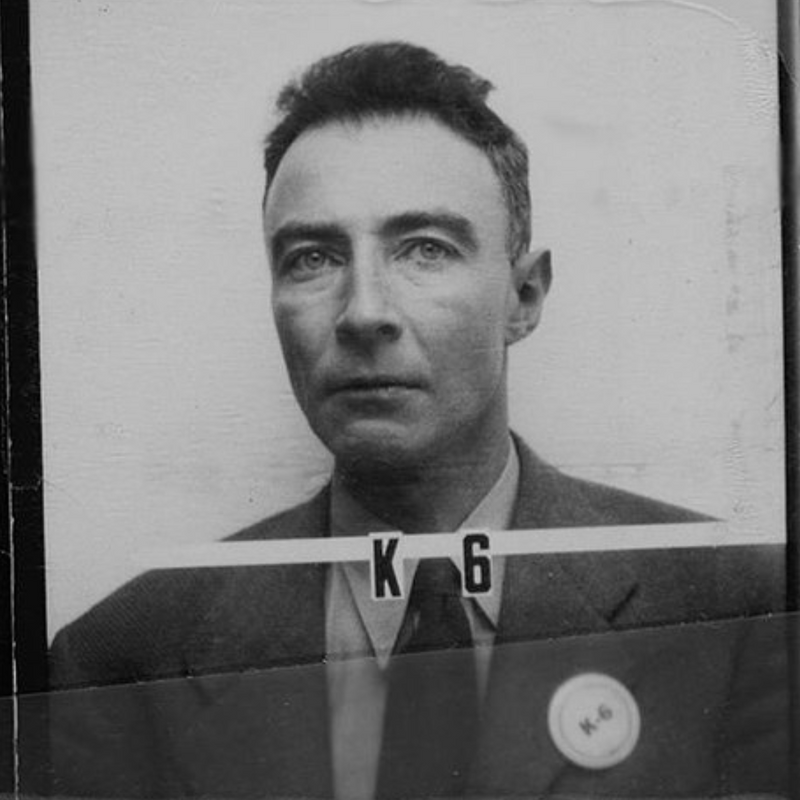
J. Robert Oppenheimer
Oppenheimer and other opponents of the H-bomb believed that there was no military need for a weapon so destructive. They called it a weapon of genocide, since its only use would be to level cities if war broke out.
It's important to note that many of the H-bomb's opponents, like Oppenheimer himself, weren't necessarily opposed to America's nuclear arsenal. Oppenheimer advocated for developing small tactical nuclear weapons that could be used on the battlefield.
Despite opposition from Oppenheimer and other notable scientists, the Truman administration began developing the H-bomb, successfully testing the weapon in 1952.
From Massive Retaliation to Flexible Response
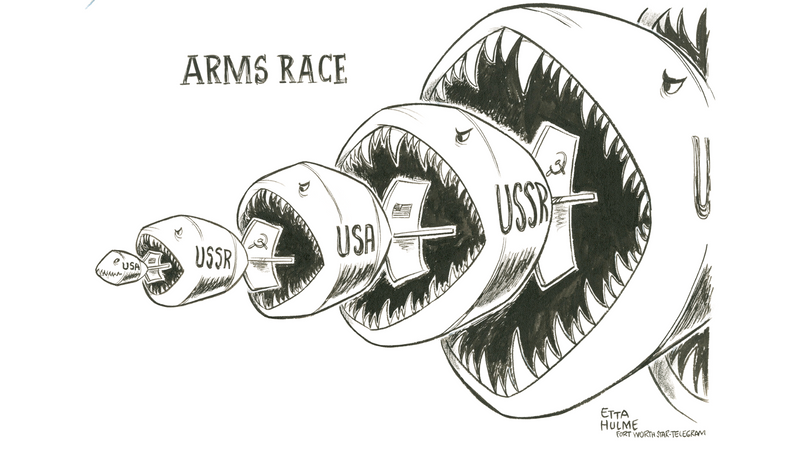
If the Cold War had yet to descend into an arms race by the end of the 1940s, it most certainly did with the development of the hydrogen bomb in the early 1950s.
The Soviet Union tested its first H-bomb in 1953 (or 1955, depending on who you ask), which began a trend toward developing increasingly more powerful and advanced weapons.
The superpowers also raced to develop smaller, tactical nuclear weapons that could be used on the battlefield. This was especially true in the United States, which used these weapons to offset the Soviet Union's conventional military superiority.
But strategists and policymakers still struggled to incorporate these weapons into military strategy.
 Eisenhower's New Look
Eisenhower's New Look
The Truman administration had considered using the bomb in the Korean War. But it was unclear how its use would provide any battlefield advantage. However, Truman's successor, President Dwight Eisenhower, went much further in emphasizing nuclear weapons in US national security policy.
Worried about the effects of a large standing conventional army on America's liberties and finances and wary of America getting dragged into another inconclusive war like that on the Korean Peninsula, Eisenhower crafted a strategy reliant on nuclear weapons — a cheaper alternative to conventional forces.
This strategy became known as Massive Retaliation.
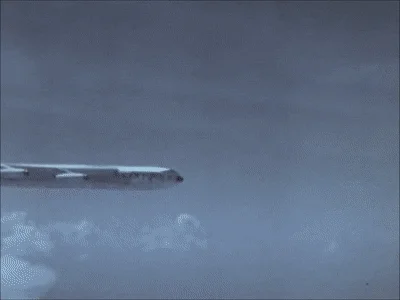
Deterring the Soviet Union (and China) from committing acts of aggression required a willingness to respond to such actions with nuclear weapons at the time and place of America's choosing: this could mean anything from Soviet cities or Chinese troop columns.
Though Eisenhower is famous for his speech on the perils of the "military-industrial" complex, America's nuclear arsenal ballooned under his watch with the development of new capabilities.
By the end of his time in office, the United States had laid the foundations of a nuclear triad, which the Soviet Union would soon acquire. The three legs of the triad are as follows:
1. Submarine Launched Ballistic Missiles (SLBM)
These are nuclear weapons delivered from submarines at sea. In their early days, missiles launched from submarines were less accurate than the other legs but the most secure since it was a challenge to detect them.
2. Intercontinental Ballistic Missiles (ICBMs)
Nuclear weapons can be delivered on missiles launched from the ground. These weapons are fast and can travel a great distance.
3. Bomber Aircraft
Nuclear weapons can be carried on bombers such as the B-52. These weapons are dropped on their targets or launched from the air.
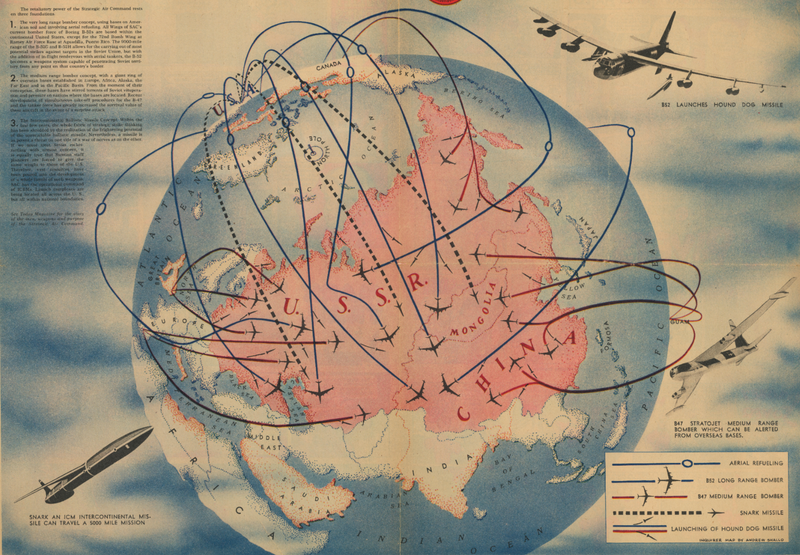
Massive Retaliation, however, was roundly criticized — and Eisenhower grew frustrated by it, too.
❌ As the Soviet Union's nuclear arsenal increased, Massive Retaliation lost credibility, and allies grew concerned. Would the United States risk a full-scale nuclear war in defense of Europe over minor crises?
❌ There was also the issue of morality. Full-scale nuclear war would indiscriminately destroy population centers.
❌ Nuclear targeting plans were also redundant, with many weapons aimed at the same targets. Criticized as "overkill," these plans provided little in the way of flexibility.
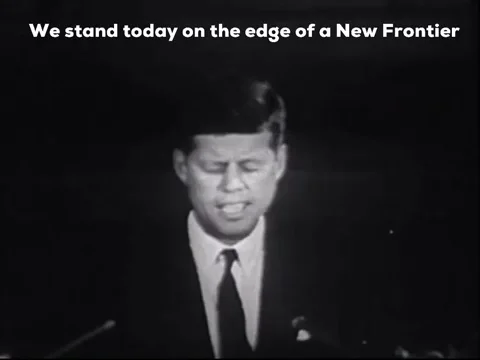
Kennedy's Flexible Response
President John F. Kennedy entered office and tried to revise Eisenhower's strategy.
His Secretary of Defense, Robert McNamara, declared that cities would be deprioritized as targets and his Pentagon got to work drafting plans that would inject more flexibility into nuclear operations.
With population centers off limits, America's strategic weapons were now to be aimed at the Soviet Union's nuclear weapons and other military targets. Such plans required more accurate weapons than those which would target cities.
 Countervalue Targeting
Countervalue Targeting
These targets include cities and other urban-industrial areas necessary to sustain a nation's society and war effort. Such targets don't require the most accurate weapons.
 Counterforce Targeting
Counterforce Targeting
These are military targets, usually an adversary's nuclear weapons. Attacking these targets, in theory, limits the damage a country that launches first would receive in a nuclear exchange. Such targets require accurate weapons.
McNamara, however, had a change of heart. He eventually concluded that no side could win a nuclear war and that the Cold War arms race heightened the risk of war.
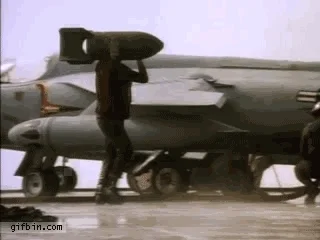
McNamara developed a policy to match this sentiment called Assured Destruction. Deterrence would hold, he argued, as long as America had well-protected weapons that could destroy a specific amount of Soviet society.
Though the United States underwent a significant nuclear build-up under his watch — developing new technology and increasing the number of its warheads — McNamara did try to reign in demands for more nuclear weapons. Guidelines for nuclear forces were established so America's arsenal didn't exceed what was sufficient for deterrence.
Determining how many nuclear weapons were enough boiled down to mathematical calculations. This sounds grim, but McNamara reasoned it was the best way to mitigate the probability that these weapons would ever be used.
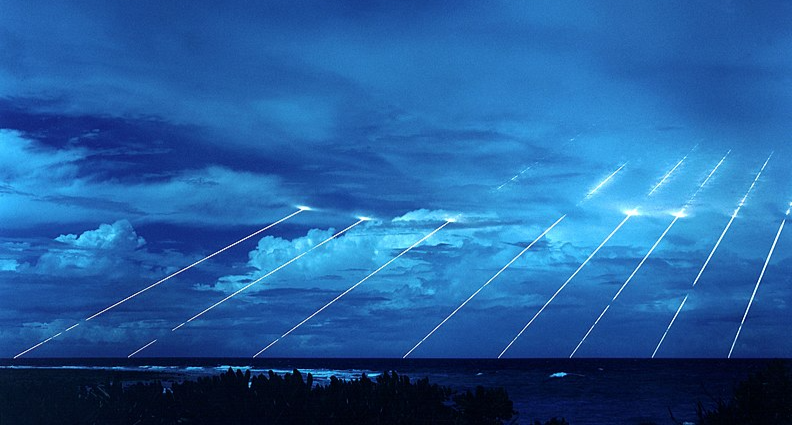
Technology Marches On
McNamara's reversal was an attempt to escape the action-reaction model described at the beginning of this Byte, which he believed had spun out of control.
➡️ The introduction of ICBMs posed challenges to strategic planners. These weapons are incredibly fast but can be protected in underground silos or on mobile vehicles.
➡️ If the United States wanted to increase the probability that they could destroy the Soviet Union's ICBMs, they needed many accurate warheads.
➡️ Multiple Independently Targetable Reentry Vehicles (MIRVs) were introduced. These weapons allowed a single ICBM to carry many warheads which could be targeted against different targets.
➡️ To counter ICBMs, the United States and the Soviet Union began to develop anti-ballistic missile defense systems (ABMs). These systems could, in theory, shoot down incoming missiles. This sounds good, but critics quickly pointed out that these systems would only propel the arms race into an even more dangerous direction.

ABM critics argued:
Effective defense was a long, long way off. A .300 batting average in baseball is stellar, but in a nuclear exchange, you want perfection.
ABMs were very expensive, especially compared to the relatively inexpensive measures that could be taken to counter them.
Nations could equip ICBMs with decoys. They could also deploy more MIRVed ICBMs to overwhelm ABM systems, accelerating the arms race.
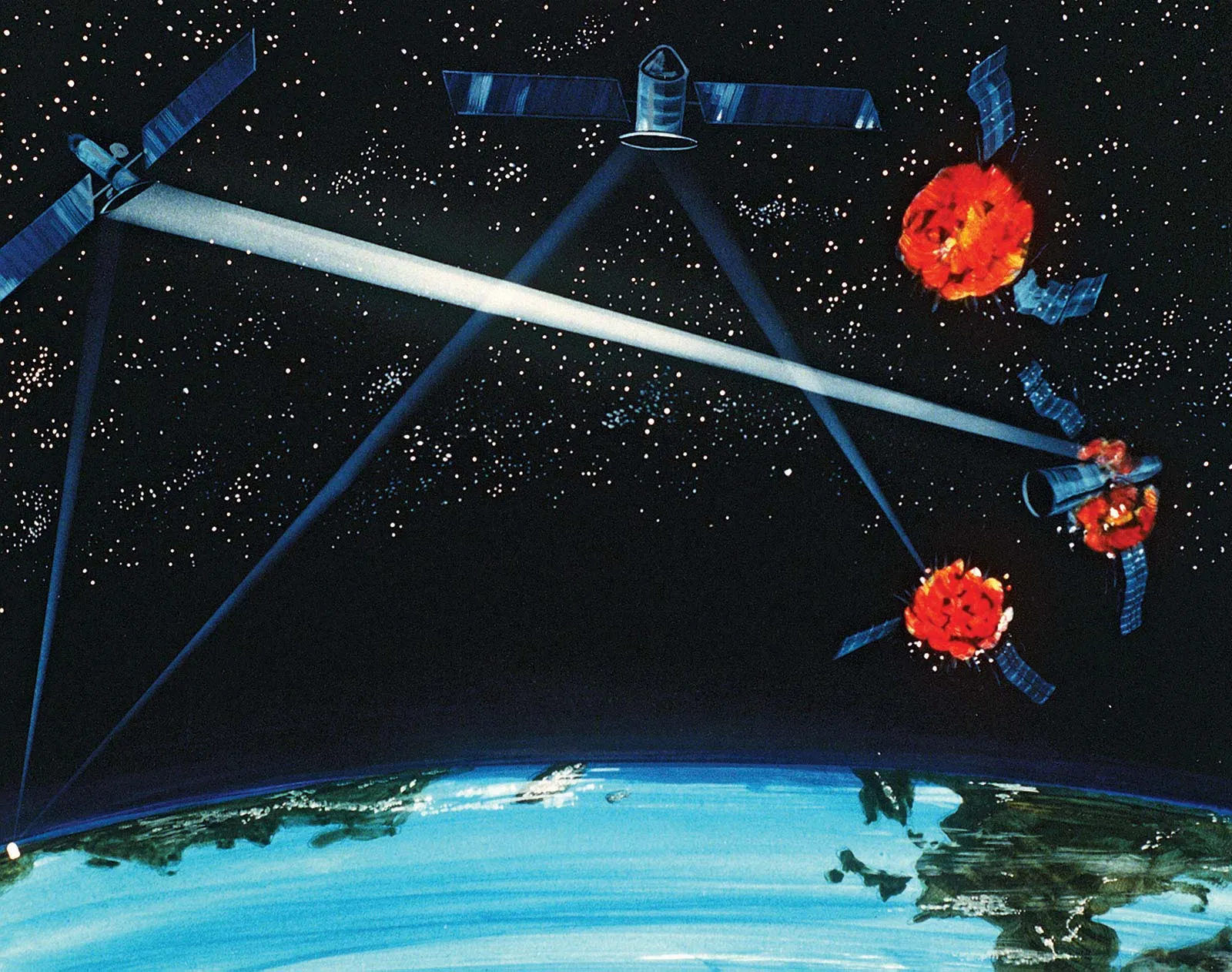
There was considerable debate in the 1960s about the necessity and dangers of missile defense. Opposition to missile defense appeared to have won when the Soviet Union and the United States signed an agreement in the early 1970s to limit the deployment of this technology. But the debate reemerged in the 1980s.
Plans for missile defense were revived during the administration of US President Ronald Reagan. Reagan's plan seemed fanciful to many, even his supporters, and was often mockingly called "Star Wars."

Much to the chagrin of its critics, the United States continues to develop missile defense systems today. Critics note ABM systems perform underwhelmingly in tests with controlled conditions. They also argue that these systems have spurred nuclear competition with China and Russia.
Parity, Now What?
America had led the arms race in the first decades of the Cold War. But, by the end of the 1960s, Washington's lead over the Soviet Union had dwindled.
The Soviet Union achieved parity with the United States. In other words, Moscow's nuclear capabilities were roughly equal to Washington's.
What parity meant for US-Soviet relations was the subject of much debate, which continues today as tensions are again high between the United States and other well-armed nuclear competitors.
You Say You Want a (Nuclear) Revolution
According to many, the United States and the Soviet Union entered a condition of Mutually Assured Destruction (aka "MAD").
Both countries had so many nuclear weapons it would be impossible for one side to destroy the other's weapons in one swift blow. They each had secure second-strike capabilities, and thanks to these capabilities, if one nation dared to attack first, they'd face destruction in a devastating counterattack.
 The United States and the Soviet Union were locked in a stalemate with no way out. According to this logic, continuing the arms race made no sense:
The United States and the Soviet Union were locked in a stalemate with no way out. According to this logic, continuing the arms race made no sense:
Increasing the number of nuclear weapons or developing new, advanced capabilities only wasted money as these investments provided no additional benefit.
Nations and their governments would take unnecessary risks if they believed they held an advantage in nuclear weapons or feared their advantage might slip away.
Supporters of this logic also held that nuclear weapons were so uniquely dangerous that they defied conventional thinking on war. They argued that if decision-makers treated nuclear weapons like any other, they might have the false impression that a nuclear war could be fought and won.

The United States and the Soviet Union, at first glance, appeared to accept this logic. In the 1960s, the superpowers began recognizing their shared interest in managing the nuclear arms race.
The 1962 Cuban Missile Crisis — which brought the United States and the Soviet Union to the edge of nuclear war when Moscow planned to deploy ballistic missiles to Cuba — spurred action to complete negotiations a year later on the 1963 Limited Test Ban Treaty.
This treaty was the first nuclear arms control agreement. It banned nuclear testing in the atmosphere, space, and underwater.
More extensive arms control agreements, which limited the deployment of ballistic missiles, were etched out in the 1970s.
These agreements were the products of the Strategic Arms Limitation Talks (SALT).

SALT I (1972)
Signed by US President Richard Nixon and Soviet leader Leonid Brezhnev, this arms control treaty placed several notable restrictions on the superpower's strategic arsenals:
Froze the number of ICBM and SLBM "launchers" each side could deploy at existing levels
An accompanying treaty limited the deployment of anti-ballistic missile defenses.

SALT II (1979)
Signed by US President Jimmy Carter and Brezhnev, this agreement placed further restrictions on the superpowers' nuclear arsenals:
Restricted not just the number of delivery vehicles each side could deploy but the number of warheads as well.
Limited the deployment of new strategic nuclear weapons.
 But even as the superpowers etched out arms control agreements, the arms race continued. While the United States and the Soviet Union placed guardrails on the quantitative arms race — the race to field more weapons than the other — America sought a qualitative advantage over the Soviets.
But even as the superpowers etched out arms control agreements, the arms race continued. While the United States and the Soviet Union placed guardrails on the quantitative arms race — the race to field more weapons than the other — America sought a qualitative advantage over the Soviets.
In other words, the United States invested in and fielded advanced capabilities and developed strategies for using these weapons.
In this environment, arms control became an outlet for competition as both superpowers strove to negotiate treaties that benefitted themselves and restricted the movement of the other.
 If, as many argued, escaping nuclear stalemate was costly, dangerous, and nearly impossible, why did the Cold War arms race continue?
If, as many argued, escaping nuclear stalemate was costly, dangerous, and nearly impossible, why did the Cold War arms race continue?
Critics of US nuclear weapons policy tend to point fingers at several culprits.
Suspects 1: Scientists, Generals, and Bureaucrats (Oh, My!)

It's easy to take for granted that a country's government comprises many individuals and organizations.
Whether a country is a democracy or a dictatorship, getting all these parts to work together in unison and with one voice can be a challenge:

While government organizations and employees are often loyal and patriotic, they also have parochial interests — such as career advancement or the burnishment of their prestige and reputation — which can sometimes steer foreign policy in suboptimal directions.

Because governments tend to be very big, different organizations specialize in various tasks, and over time, unique traditions and ways of doing things get established. For example, the United States military has multiple services specializing in specific types of combat: the Air Force fights in the air, the Navy at sea, and the Army on land.

Organizations often compete with one another for roles, funding, and attention.
So what does this have to do with nuclear weapons?
These dynamics often come into play on issues related to the research, development, and deployment of weapons. Organizations define their priorities, lobby for budgets, and usually begin projects that don't receive much external debate.

At times, scientists and designers of nuclear weapons may have been driven by the impulse to push boundaries to create technology that didn't yet have a purpose or whose repercussions were not thoroughly thought through.

Generals and military officers trained and schooled on traditional military tactics, in which weapons have a clear battlefield purpose, may have pushed the United States to develop increasingly accurate weapons to attack military targets.

Rivalry among and within military organizations — and a concern about being left out of America's nuclear enterprise — has sometimes led to the development of new technologies.
For instance, competition with the Air Force likely contributed to the US Army's support for missile defense, its acquisition of tactical nuclear weapons, and the US Navy's development of submarine-launched ballistic missiles.
While organizational and bureaucratic politics may have pushed the United States into a decades-long arms race, there are also instances in which US military organizations have pushed back against investment in new weapons.
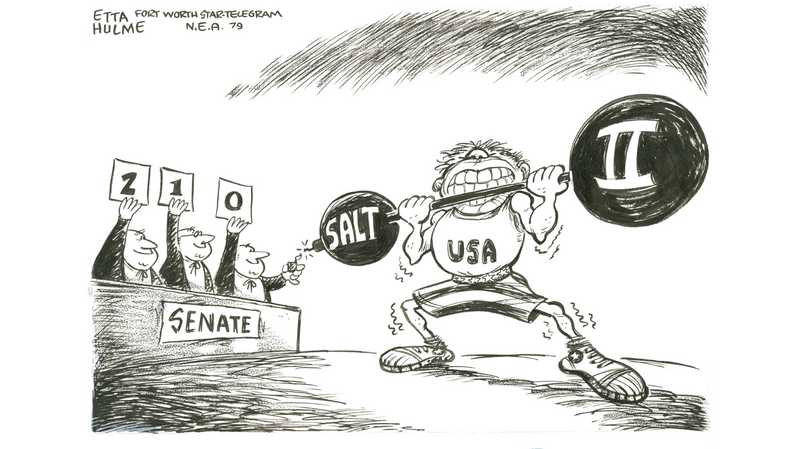
Suspect 2: Politics
One would think politics would be cast aside when debating something as serious as nuclear weapons. But this was often not the case. Nuclear weapons policy was an issue that could be used to score partisan points and cast political opponents as weak on defense.
Mind the Gap(s)
Presidents and their political parties were accused of not taking the Soviet threat seriously and pursuing policies that made the United States vulnerable.
Politicians sounded the alarm that gaps had formed between Soviet and American capabilities.
 Bomber Gap
Bomber Gap
There was much alarm in the mid-1950s that the Soviet Union had many more heavy bombers than the United States.
Bombers were important at the time, since they were the only means the United States or the Soviet Union had to deliver nuclear weapons. Air defense systems provided excellent protection, which meant the country with the most bombers had the best odds of reaching their targets.
There had been warnings that America was falling behind, and Democrats in the US Senate picked up the charge. They held hearings on the matter, but President Eisenhower — a Republican who resisted increased defense spending — wasn't worried.
The Soviet Union had deceived those who sounded the alarm, whose evidence included photos of bombers at a Soviet airshow. As it turned out, these photos featured aircraft which had flown in circles. What was believed to be many planes were a few.
 Missile Gap
Missile Gap
Senate Democrats and others came after Eisenhower again later in the decade. This time, they alleged America had fallen behind in ICBM development.
ICBMs were a new technology that would have allowed the Soviets and Americans to attack one another quickly from great distances. And many Americans came to believe that Soviet technology was much superior.
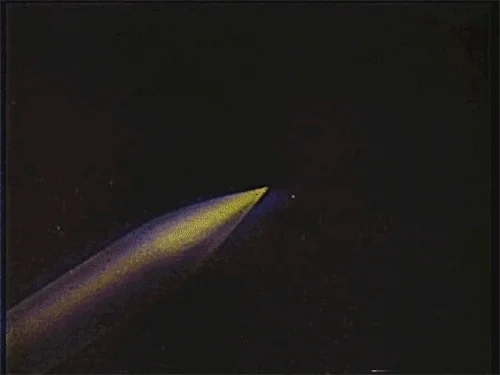
The Soviets successfully tested an ICBM in 1957. Not long after, the Soviets launched Sputnik, the world's first satellite, into space. This launch appeared to underscore Moscow's technical prowess and gave the impression that the Soviets were winning the space race.
Then there was the Gaither Report. This study, commissioned by the Eisenhower administration, assessed that the Soviets would have the ICBM capability to launch a devastating surprise attack by the decade's end.
The Gaither Report's findings were leaked to the press, where they were picked up by Senate Democrats, including then-presidential hopeful John F. Kennedy, to paint the Republican administration as weak.
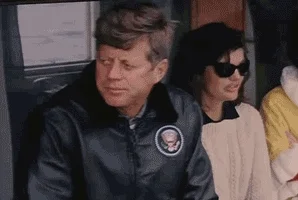
JFK sincerely believed there was a missile gap and made it an issue in his presidential campaign. But classified CIA estimates showed that while there was indeed a gap, it was not the Soviets in the lead but, in fact, the United States.
When he became president, Kennedy was shocked — and a little embarrassed — to learn that America was in the lead.

Window of Vulnerability
Later in the Cold War, those from both political parties who fashioned themselves as "hawks" accused the Republican administrations of Richard Nixon and Gerald Ford and the Democratic administration of Jimmy Carter as soft on defense.
They lambasted détente, arms control negotiations, and decisions to scrap weapons programs, which, they argued, had allowed the Soviet Union's deployment of more destructive ICBMs to go unchallenged.
It was believed that in the 1980s, there would be a window in time in which the Soviets could successfully launch a devastating first strike against the United States.

Intelligence estimates became politicized in this environment. The CIA was accused of underestimating the Soviet Union's strength.
During the Ford administration, a B-team of outside experts was given classified data to fact-check the CIA.
The B-teams analysis was alarmist and, according to historians, inaccurate. Nevertheless, their findings were influential among conservative foreign policy experts and coincided with significant efforts to turn American public opinion against arms control.
Suspect 3: Uncertainty
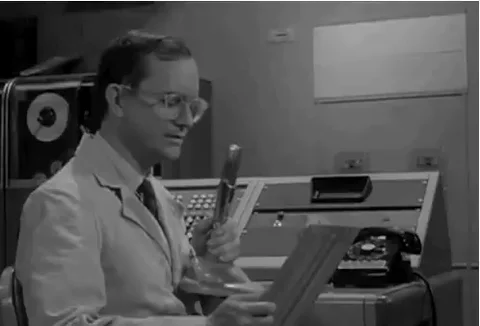
There are many good arguments for why the Cold War arms race was unnecessary, dangerous, and costly.
But given the intensity of the geopolitical tensions between the superpowers, there are also well-informed arguments that it was prudent for America to engage in an arms race with the Soviet Union.

Delicate Balance
The logic of MAD says that because the power of nuclear weapons is so great, deterrence is held as long as both the United States and the Soviet Union have secure second-strike capabilities.

While some argued that this stalemate was more or less permanent, others claimed it was much more fragile.
The strategic nuclear triads of the United States and the Soviet Union — their submarines, ICBMs, and bombers — could become vulnerable to attack due to significant technological shifts.
For example, though submarines were long thought to be the most secure way to deliver nuclear weapons, the Americans were good at tracking Soviet subs throughout the Cold War.
Nuclear weapons need communications and information technology to run effectively. But these were vulnerable to attack. If lines of communication were severed, a country might not be able to respond to a nuclear strike against its homeland.

Even if the nuclear balance was more stable than it was delicate, was it worth taking the chance?
Discerning whether America was indeed vulnerable was made even more difficult because it was hard to peer into the Soviet Union to gain an accurate understanding of its capabilities.
American reconnaissance aircraft such as the U-2 spy plane, the SR-71 Blackbird, and satellites helped. But figuring out another country's motivations and intentions was even more difficult.
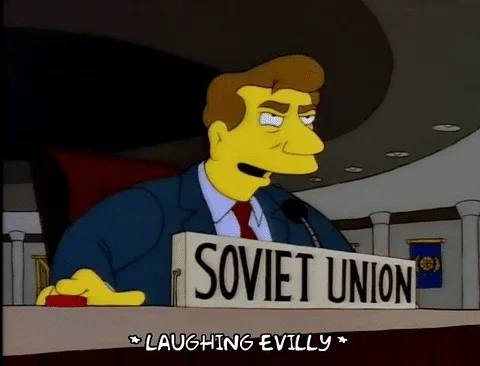
Did the Soviets or the Americans even understand the logic of MAD?
On the face of it, the United States and the Soviet Union's arms control efforts indicated that both countries ascribed to the tenets of mutually assured destruction — that is, they understood relations were more stable if they were both vulnerable to a nuclear attack.

But, from the perspective of American policymakers, the Soviet Union's negotiating positions, words, and deeds indicated that they thought differently: that a nuclear war could be fought and won.
The Soviet military had much input in Moscow's nuclear thinking. These officers and generals could have thought about nuclear weapons like traditional weapons of war.
The Soviets were thought to have a robust civil defense program, which indicated that the Soviets intended to emerge from a nuclear war in better shape than the United States.
Not to mention, communist ideology believed in its eventual triumph over capitalism.

If this was, indeed, how the Soviets thought about nuclear weapons, Washington's only way to deter the Soviet Union was to think about nuclear weapons similarly.
Successive American presidencies attempted to develop plans which would give them more flexibility and precision in selecting targets for nuclear strikes.
Rather than building weapons geared toward destroying cities, weapons were developed to attack the Soviet Union's nuclear weapons.
The Carter and Reagan administrations went the farthest in developing nuclear strategies allowing the United States to "endure" a nuclear war.

Did nuclear superiority have its benefits?
Others weren't content with a future in which the United States and the Soviet Union accepted their shared vulnerability to nuclear attack. These people argued that Washington benefited from having an edge over Moscow.
A more robust arsenal could give the United States an advantage during crises.
Policymakers were also wary of the opinion of America's European allies. They feared that allies would question Washington's defense commitments if the United States didn't believe it could survive a nuclear war.
Allies might defect from the NATO alliance, become neutral, or even make peace with the Soviet Union. After all, why would the United States destroy itself to protect Amsterdam?
We'll leave it to you to decide who or what was to blame for the Cold War arms race. Or if there is anyone or anything that should even be blamed.
Consequences

The Cold War began to thaw in the late 1980s as Soviet leader Mikhail Gorbachev issued reforms that opened the Soviet economy and allowed for greater freedom of expression.
At the same time, the Communist Party began to lose its grip on the Soviet Union. By the end of 1991, the USSR had officially dissolved.
Gorbachev's reforms were reflected in how he approached the arms race. He proposed to the United States a plan to eliminate all nuclear weapons by the year 2000.
Though dismissed as propaganda, Gorbachev, nevertheless, found common cause with US President Ronald Reagan in putting the breaks on Washington's and Moscow's nuclear competition.
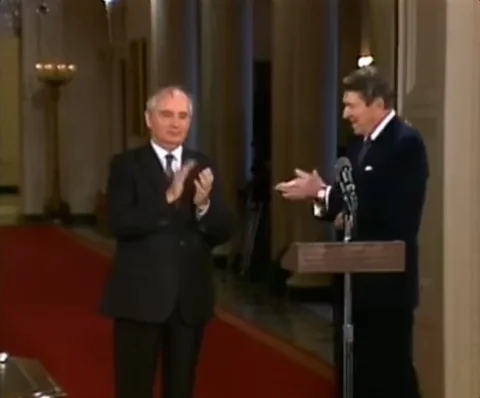
They were an unlikely pair. Reagan, for his part, was very anti-communist and a defense hawk who was critical of arms control.
The two leaders negotiated significant arms control agreements.
 Intermediate-Range Nuclear Forces Treaty (1987)
Intermediate-Range Nuclear Forces Treaty (1987)
It prohibited the United States and the Soviet Union (later Russia) from deploying nuclear missiles in Europe, ranging from 500 to 5,500 kilometers.
 Strategic Arms Reduction Treaty (1991)
Strategic Arms Reduction Treaty (1991)
Reagan laid the foundation of this treaty that his successor, President George H.W. Bush, signed. This treaty was the first nuclear arms control agreement to reduce the number of strategic weapons.
With the collapse of the Soviet Union in the early 1990s, the Cold War arms race ended. Nuclear competition between the United States and Russia became less intense, though it never completely disappeared.
The United States and Russia continued modernizing their arsenals while the legacy of the Cold War's arms control agreements eroded.
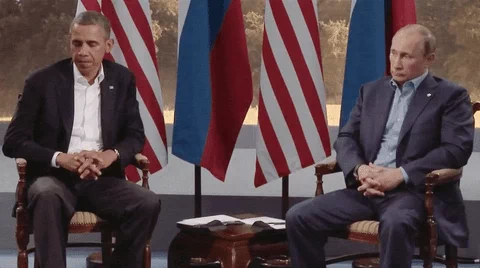
Looking back at the Cold War arms race, it's essential to understand its consequences.
Era of Crisis
Perhaps what is most notable about the Cold War is that nuclear war was narrowly avoided multiple times. Deep geopolitical tensions between the large nuclear arsenals of the United States and the Soviet Union raised the stakes of the era's geopolitical crises.
Notable close calls include:
The Middle East's 1973 October War, when the United States placed its nuclear forces on high alert as a warning to the Soviet Union
Assurance and Deterrence?
While some may stress the dangers of the Cold War's close calls, others argue that a direct conflict was avoided because America chose to engage the Soviet Union in an arms race.
By maintaining a robust nuclear deterrent, Washington may have made Moscow think twice about invading Western Europe. It may have also made America's allies feel secure and incentivized to stick with the United States.
Or perhaps war never broke out for reasons entirely different: international attitudes became repulsed by war — especially one fought with nuclear weapons.
Cost for the United States
Accounting is complex, but America's Cold War nuclear enterprise may have cost the United States $5.8 trillion.
After the post-WWII economic boom, defense spending partly contributed to America's economic problems in the 1960s and 70s.
This is one of the reasons leaders such as US Presidents Lyndon B. Johnson and Richard Nixon pursued détente and arms control with the Soviet Union. They wanted to ease the burden defense spending placed on the economy.
America emerged victorious from the Cold War, so this spending may have been necessary to keep America secure. But perhaps, money could have been spent better elsewhere.
Every gun that is made, every warship launched, every rocket fired signifies, in the final sense, a theft from those who hunger and are not fed, those who are cold and are not clothed. This world in arms is not spending money alone.
— US President Dwight D. Eisenhower
Cost for the Soviet Union
The Soviet Union's arms build-up placed an even heavier burden on its economy. According to one estimate, by 1960, defense spending comprised 20% of the country's annual budget.
Moscow struggled to keep pace with the acceleration of America's defense spending during the first term of the Reagan administration. Many argue the burden this placed on the Soviet Union's economy led to the country's collapse.

This may be one cause, but there were other factors at play:
There was a surge in nationalism as the Soviet republics, including Russia, sought independence.
Corruption and poor economic planning by the Communist Party.
Others argue Gorbachev's reforms were misguided, worsened the financial situation, and intensified nationalistic sentiment.
Military-Industrial Complex
The Cold War was as much of a science and technology competition as a military one.
At times, the superpowers relied more on brainpower than brute force. They competed to prove that their societies were more advanced and scientifically capable than the others.
This competition helped humanity get to the moon and develop the GPS in your phone, but it also led to the development of sophisticated weapons.
The United States formed a tight relationship with scientists and business people to succeed. The Cold War was a boon for defense contracting.

No longer was the Midwest the industrial heart of America. Industry moved to sunny Southern California, Florida, Texas, and other states in America's sunbelt. This is where many of the nation's private aerospace and defense corporations flushed with government contracts set up shop.
It wasn't just weapons manufacturers either. Some of the Cold War's most influential thinkers set up shop in California. The RAND Corporation — a prominent think tank contracted by the US Air Force — found a home in Santa Monica.
Though the military-industrial complex created many jobs and opportunities, it also created many problems.
President Eisenhower did much to create and encourage the growth of the military-industrial complex. Still, when he left office, he warned Americans about its undo influence on American society and foreign policy.

Nuclear weapons also impacted communities in the United States, the Soviet Union, and around the globe. People who lived near nuclear test sites were displaced and exposed to harmful fallout.
Radioactive particles from Cold War atmospheric nuclear testing can still be detected today.
Nuclear Proliferation

The arms race between the United States and the Soviet Union wasn't the only important dynamic in the atomic age. Another, more global one, was the horizontal spread of nuclear weapons.
Vertical Proliferation
The increase in the number and types of weapons within a country's arsenal.
Horizontal Proliferation
The spread of nuclear weapons among countries — when people talk about nuclear proliferation, this is the type they usually mean.
The potential for these weapons to spread around the globe was not lost on early Cold War policymakers.
Some Manhattan Project scientists warned that using the A-bomb in World War II would open the door to the spread of atomic weapons around the globe.
Under the Truman administration, laws were enacted to keep information secret that could be used to research and develop these weapons.
There was even a failed attempt in the 1940s by the United States to place these weapons under international control.
 The superpowers, however, struggled to create coherent Cold War nonproliferation policies. Occasionally, the United States and the Soviet Union even encouraged countries to acquire nuclear weapons.
The superpowers, however, struggled to create coherent Cold War nonproliferation policies. Occasionally, the United States and the Soviet Union even encouraged countries to acquire nuclear weapons.
Atoms for Peace
Nuclear technology had the potential to unleash untold destruction. But it also had a more peaceful use: atomic energy.
President Eisenhower encouraged the use of nuclear energy for peaceful purposes. Speaking at the United Nations, he urged countries with nuclear programs to make fissionable material available to the world. Such activity would be internationally monitored by an organization we know today as the International Atomic Energy Agency (IAEA).

The Eisenhower administration's motivations were three-fold:
A sincere belief in the ability of nuclear technology to foster development and improve living standards.
Legitimize nuclear weapons and improve international opinion towards American nuclear weapons policy.
Score propaganda points against the Soviet Union.
Eisenhower's vision was years in the making. In the meantime, the United States sold nuclear materials to countries to help them build nuclear reactors.
Eisenhower's Atoms for Peace program has a mixed legacy. On the one hand, it gave countries the foundations needed to create weapons. On the other, it set the stage for the IAEA, a pillar of today's nonproliferation regime.

Soviet Union and China
The Soviet Union and China were close allies following the Communist victory in China's civil war. And under the leadership of Nikita Khrushchev, the Soviets agreed to aid China's nuclear program.
These two countries, however, did not stay friends for long. Tensions grew between the two, and the Soviets increasingly worried that Chinese leader Mao Zedong would not be a responsible steward of a nuclear-armed China.
The agreement was called off, but Moscow continued to worry. China's program advanced, which raised alarm in both the United States and the Soviet Union.
Closing Pandora's Box
Nuclear proliferation — or at least its prospect — became more of a concern in the 1960s and 70s.
Proliferation was one of the reasons President Kennedy concluded test ban negotiations with the Soviet Union. He worried that in the 1970s, the world could see as many as 25 countries with nuclear weapons.
Several trends suggested that Kennedy could be right:
The United States and the Soviet Union, though still superpowers, were less dominant than they once were as other countries recovered from World War II and became more powerful.
The Cold War arms race had much to do with it as well. The competition between Moscow and Washington helped legitimize nuclear weapons by demonstrating that they were essential to a country's national security.
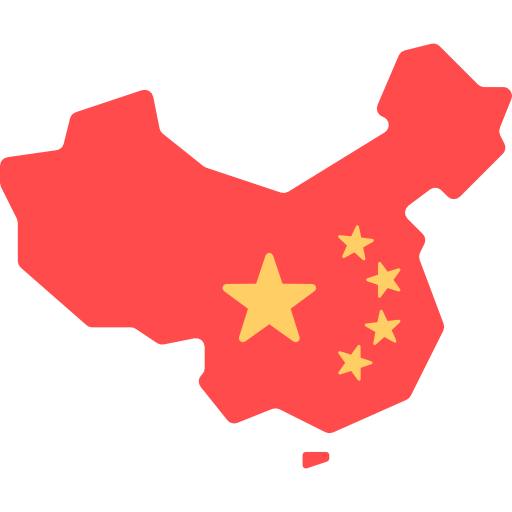
Then there was China...
China tested its first nuclear device in October 1964, which led the United States to rethink its approach to nuclear proliferation. China's test portended a geopolitical seachange:
Developing countries could look to China's program as a model for their own nuclear weapons programs.
A nuclear China could undermine American influence in Asia.
It could also unleash a wave of proliferation among nations that already possessed the capability to develop a bomb, such as West Germany, Japan, South Korea, India, Argentina, and Egypt.
Nonproliferation Treaty (1968)
China's test prompted US President Lyndon B. Johnson to establish a task force to study American nonproliferation policy. Known as the Gilpatric Committee, the task force's conclusions helped push America to take nonproliferation more seriously.
In practice, this meant America would sometimes have to reign in the nuclear ambitions of its allies and even find a common cause with its adversary, the Soviet Union.
Washington and Moscow went on to negotiate the framework for the 1968 Nonproliferation Treaty. Still, the spread of nuclear weapons remained a problem to be managed. Some Cold War leaders, like President Carter, took it more seriously than others.
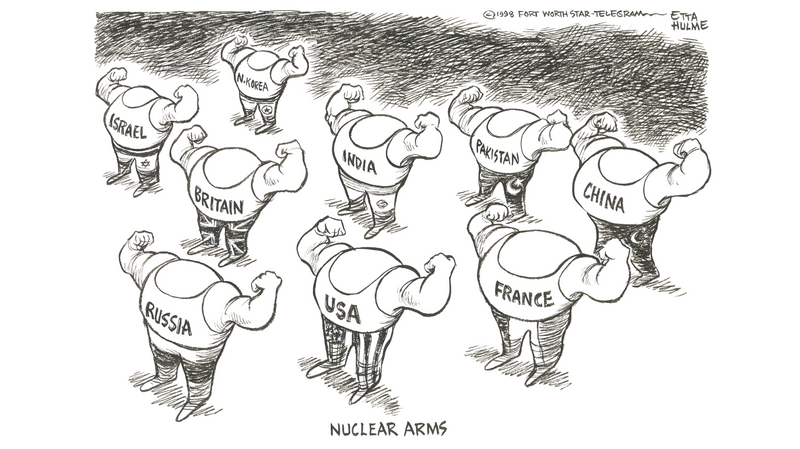
Today, the number of nuclear-armed countries is much smaller than what Kennedy feared. Nine nations have nuclear weapons — China, France, India, Israel, North Korea, Pakistan, the United Kingdom, the United States, and Russia.
Take Action
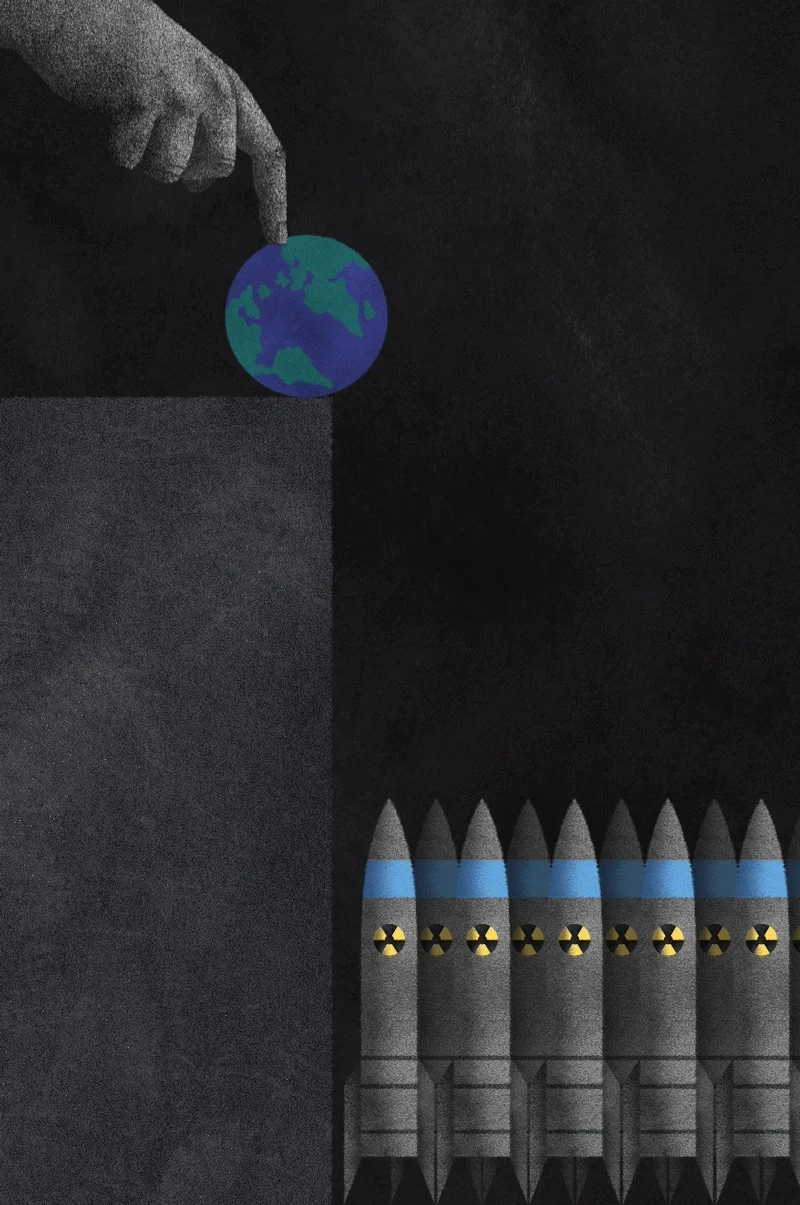
If the Cold War was the world's first nuclear era, it appears the world is on the cusp of its second nuclear era.
Russia's war in Ukraine and President Vladimir Putin's nuclear saber-rattling may indicate that nuclear weapons will again take center stage in global politics.
There are other troubling signs as well:
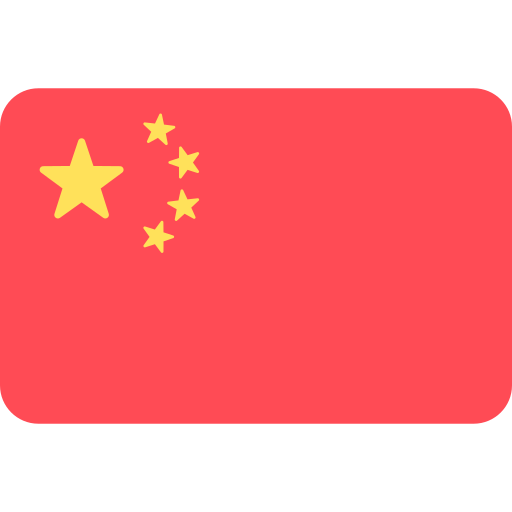 China is rapidly building up its nuclear arsenal — though it is far from matching America's capabilities.
China is rapidly building up its nuclear arsenal — though it is far from matching America's capabilities.
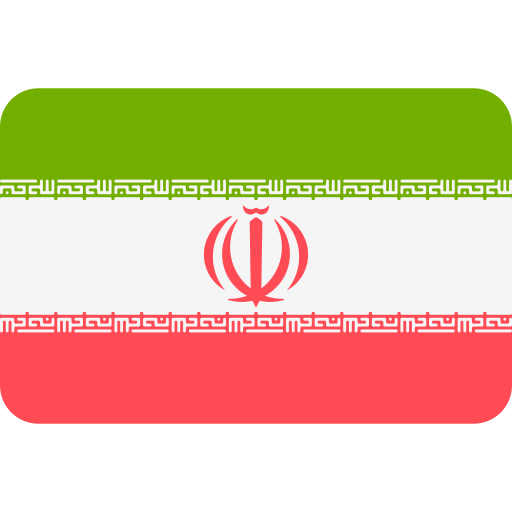 Iran could, if it so desires, develop a weapon in a matter of months.
Iran could, if it so desires, develop a weapon in a matter of months.
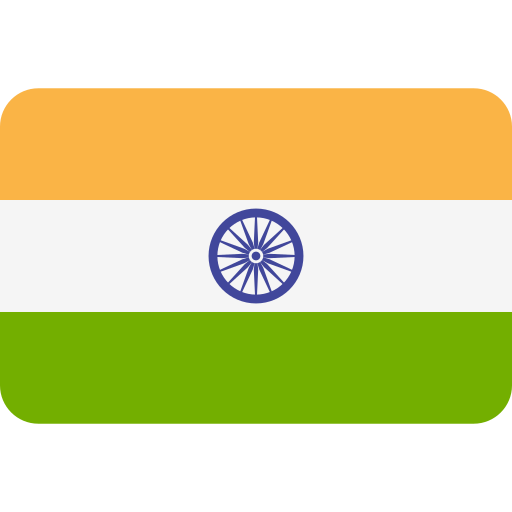 Tensions persist between nuclear-armed India...
Tensions persist between nuclear-armed India...
 ...and nuclear-armed Pakistan, who are both building more robust capabilities.
...and nuclear-armed Pakistan, who are both building more robust capabilities.
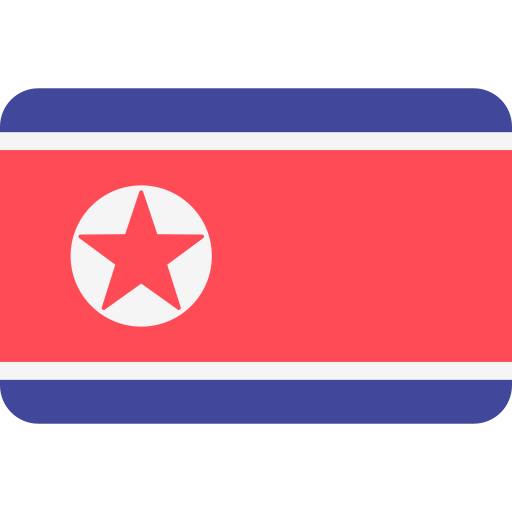 North Korea's nuclear program marches on.
North Korea's nuclear program marches on.
 Russia possesses a formidable nuclear arsenal, is developing new "exotic" nuclear capabilities, and has suspended its participation in New START — its last remaining nuclear arms control agreement with the United States, which limits the number of strategic warheads each side can deploy.
Russia possesses a formidable nuclear arsenal, is developing new "exotic" nuclear capabilities, and has suspended its participation in New START — its last remaining nuclear arms control agreement with the United States, which limits the number of strategic warheads each side can deploy.
 The United States withdrew from important arms control agreements during the Trump administration and is modernizing its nuclear arsenal. At the same time, some commentators call on the United States to ditch arms control entirely.
The United States withdrew from important arms control agreements during the Trump administration and is modernizing its nuclear arsenal. At the same time, some commentators call on the United States to ditch arms control entirely.
And this appears to have many American survey takers worried.

So what should we do?
Though the horizontal spread of nuclear weapons has been the focus of much of the world's attention since the fall of the Soviet Union, competition between heavily armed nuclear adversaries may once again occupy the minds of the world's leaders.
As policymakers look ahead to the future, it's essential to study the Cold War arms race to learn its lessons on what we should do and what we shouldn't do.

But this history should also be approached with caution. Some lessons may or may not apply to today's geopolitical environment:
The Cold War's arms race was a faceoff between two countries: the United States and the Soviet Union.
But today, three heavily-armed nuclear powers are in the ring: China, the United States, and Russia.
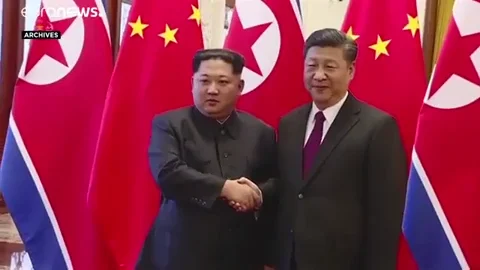
To learn more about the Cold War arms race and today's nuclear era, you can check out these resources:
Your feedback matters to us.
This Byte helped me better understand the topic.

